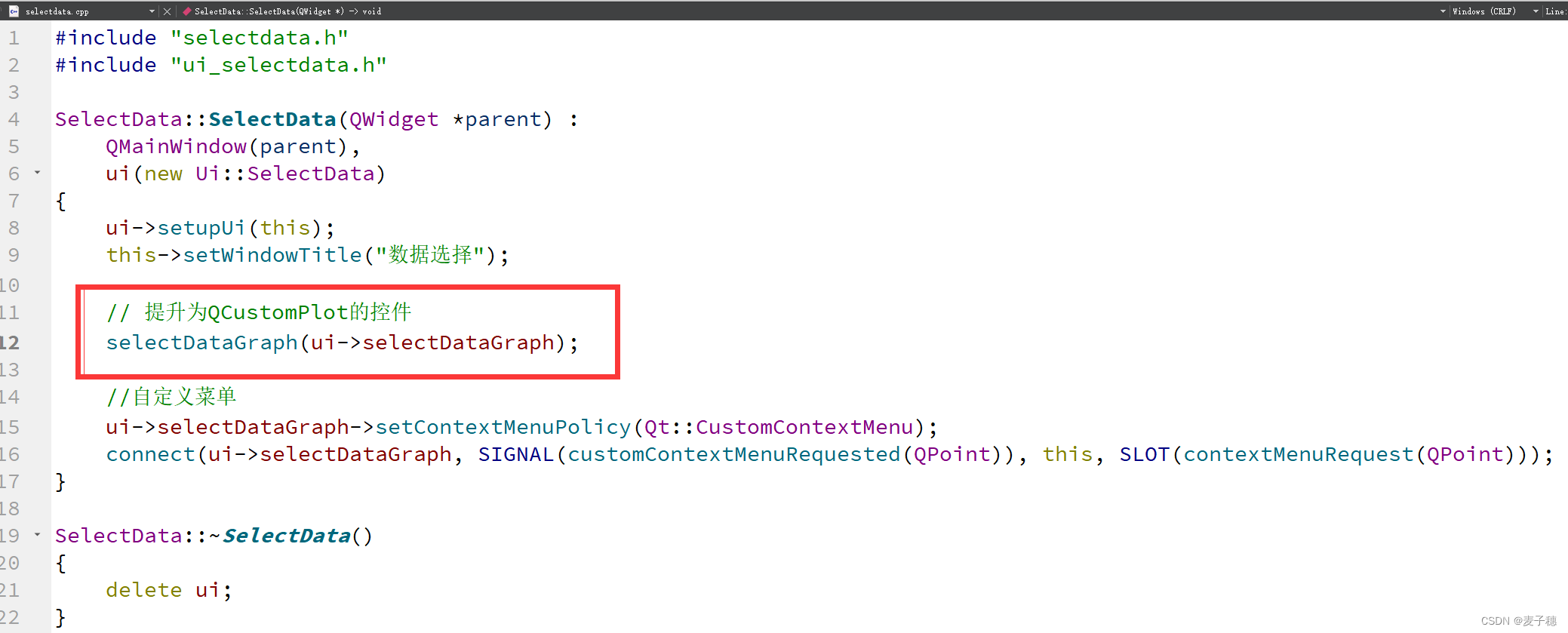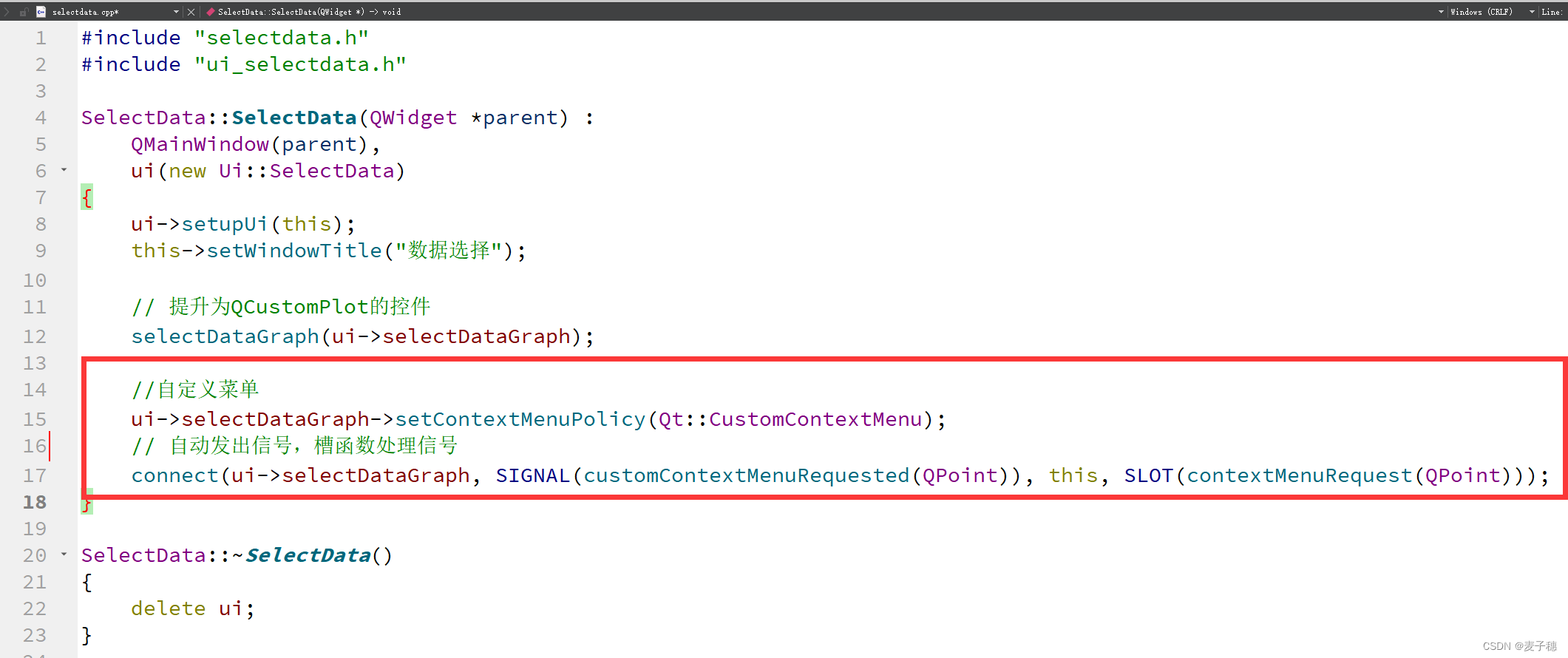画图之前一定要下载QCustomPlot,下载后还要在QT中引入QCustomPlot,然后拖出Widget控件,将其提升为QCustomPlot。
详细操作我在上个文章中写过,请参考QT绘图用QCustomPlot库,简单画一个曲线图,涉及了QCustomPlot的最基础知识(画图必用到的属性)_麦子穗的博客-CSDN博客_qt画曲线
先看运行后的效果图。
1654153283344
项目头文件代码:
1. 引入QCustomPlot的头文件(必须引入,不然会报错)
#include "qcustomplot.h"2. 在头文件中声明两个函数
selectDataGraph(QCustomPlot *customPlot);此函数用来绘图
selectData(QCustomPlot *customPlot);此函数用来设置选择数据的相关属性或者参数
// 绘图
void selectDataGraph(QCustomPlot *customPlot);
// 选择图形中的数据
void selectData(QCustomPlot *customPlot);3. 在头文件中声明私有槽函数用来实现数据选择和曲线的显示与隐藏
private slots:
// 设置显示/隐藏菜单
void contextMenuRequest(QPoint pos);
// 选中图例中的项,或者选中曲线时
void showGraph();
// 被选中的曲线隐藏
void hideGraph();
// 显示框选数据
void selectedShow();项目文件.cpp代码:
1. 在设计界面拖动一个Widget控件提升为QCustomPlot,此控件的类名设置为selectDataGraph。
在构造函数中调用绘图函数时,需要将此控件作为参数传进去。代码如下

2. 绘图函数代码实现
//绘图
void SelectData::selectDataGraph(QCustomPlot *customPlot)
{
customPlot->legend->setVisible(true);
customPlot->legend->setFont(QFont("Helvetica",9));
QPen pen;
//曲线风格
QStringList lineNames;
lineNames << "lsNone" << "lsLine" << "lsStepLeft" << "lsStepRight" << "lsStepCenter" << "lsImpulse";
for(int i = QCPGraph::lsNone;i <= QCPGraph::lsImpulse; ++i)
{
customPlot->addGraph();
pen.setColor(QColor(qSin(i*1+1.2)*80+80, qSin(i*0.3+0)*80+80, qSin(i*0.3+1.5)*80+80));
customPlot->graph()->setPen(pen);//设置图表的画笔
customPlot->graph()->setName(lineNames.at(i-QCPGraph::lsNone));
customPlot->graph()->setLineStyle((QCPGraph::LineStyle)i); // 设置图表线段的风格
customPlot->graph()->setScatterStyle(QCPScatterStyle(QCPScatterStyle::ssCircle, 5)); // 设置图表散点图的样式
//数据
QVector<double> x(15), y(15);
for (int j=0; j<15; ++j)
{
x[j] = j/15.0 * 5*3.14 + 0.01;
y[j] = 7*qSin(x[j])/x[j] - (i-QCPGraph::lsNone)*5 + (QCPGraph::lsImpulse)*5 + 2;
}
customPlot->graph()->setData(x, y);
customPlot->graph()->rescaleAxes(true);
}
//选中后,放大一点
customPlot->xAxis->scaleRange(1.1,customPlot->xAxis->range().center());
customPlot->yAxis->scaleRange(1.1,customPlot->yAxis->range().center());
customPlot->xAxis->setTicks(true);
customPlot->yAxis->setTicks(true);
customPlot->xAxis->setTickLabels(true);
customPlot->yAxis->setTickLabels(true);
//标题元素
customPlot->plotLayout()->insertRow(0);
QCPTextElement *title = new QCPTextElement(customPlot, "数据与图例的选中,曲线的显示与隐藏,放大被框选数据", QFont("sans", 17, QFont::Bold));
customPlot->plotLayout()->addElement(0, 0, title);
customPlot->xAxis->setLabel("x轴");
customPlot->yAxis->setLabel("y轴");
customPlot->axisRect()->setupFullAxesBox();
selectData(customPlot);
}3. 数据选择代码实现:
//数据选择
void SelectData::selectData(QCustomPlot *customPlot)
{
//交互设置 拖拽 缩放 选中轴 选中图例 选中图表标签 多选方式
customPlot->setInteractions(QCP::iRangeDrag | QCP::iRangeZoom | QCP::iSelectAxes | QCP::iSelectLegend | QCP::iSelectPlottables | QCP::iMultiSelect);
customPlot->setMultiSelectModifier(Qt::ControlModifier);// 使用ctrl键来多选
customPlot->xAxis->setSelectableParts(QCPAxis::spAxis | QCPAxis::spAxisLabel | QCPAxis::spTickLabels); // 轴的三个部分都可以被选择
customPlot->yAxis->setSelectableParts(QCPAxis::spAxis | QCPAxis::spAxisLabel | QCPAxis::spTickLabels);
customPlot->legend->setSelectableParts(QCPLegend::spItems);// 图例本身不能被选择,只有里面的项可以被选择
customPlot->legend->setSelectedIconBorderPen(Qt::NoPen);// 设置图例里的项被选择时不显示Icon的边框
customPlot->selectionRect()->setPen(QPen(Qt::black,1,Qt::DashLine));//设置选框的样式:虚线
customPlot->selectionRect()->setBrush(QBrush(QColor(0,0,100,50)));//设置选框的样式:半透明浅蓝
customPlot->setSelectionRectMode(QCP::SelectionRectMode::srmZoom);//被框选的曲线放大
//鼠标框选选中曲线,解开以下注释可查看效果
// customPlot->setSelectionRectMode(QCP::SelectionRectMode::srmSelect);//被框选的曲线放大
// for (int i=0; i < customPlot->graphCount(); ++i) {
// QCPGraph *graph = customPlot->graph(i);
// //可以选择多个连续的数据点(一个数据范围)。
// graph->setSelectable(QCP::stDataRange);
// }
// 连接QCustomPlot的信号,selectionChangedByUser表明是由鼠标点击进行的选择
// 这里主要就是同步图表和图例的显示
connect(customPlot, &QCustomPlot::selectionChangedByUser, this,&SelectData::selectedShow);
}4. 选中图例中的项,或者选中曲线时
// 选中图例中的项,或者选中曲线时
void SelectData::selectedShow()
{
for (int i=0; i < ui->selectDataGraph->graphCount(); ++i) {
QCPGraph *graph = ui->selectDataGraph->graph(i);
QCPPlottableLegendItem *item = ui->selectDataGraph->legend->itemWithPlottable(graph);//图例中的每一个项
//选中图例中的项,或者选中曲线时,两者都被选中
if (item->selected() || graph->selected())
{
graph->setSelection(QCPDataSelection(graph->data()->dataRange()));// 当图例项被选择时,选择图表全部的数据
item->setSelected(true);
}
}
}5. 设置显示/隐藏菜单
需要在构造函数中,设置自定义菜单,并连接信号。
//自定义菜单
ui->selectDataGraph->setContextMenuPolicy(Qt::CustomContextMenu);
// 自动发出信号,槽函数处理信号
connect(ui->selectDataGraph, SIGNAL(customContextMenuRequested(QPoint)), this, SLOT(contextMenuRequest(QPoint)));
如图

函数实现:
// 设置显示/隐藏菜单
void SelectData::contextMenuRequest(QPoint pos)
{
QMenu *menu = new QMenu(this);
menu->setAttribute(Qt::WA_DeleteOnClose);
double legendCounts = ui->selectDataGraph->legend->selectTest(pos, false);
double graphCounts = ui->selectDataGraph->graph()->selectTest(pos,false);
//图例菜单
if (( legendCounts >= 0) || ( graphCounts >= 0))
{
menu->addAction("显示", this, SLOT(showGraph()));
menu->addAction("隐藏", this, SLOT(hideGraph()));
}
menu->popup(ui->selectDataGraph->mapToGlobal(pos));
}6.被选中的曲线显示
// 被选中的曲线显示
void SelectData::showGraph()
{
for (int i=0; i<ui->selectDataGraph->graphCount(); ++i)
{
QCPGraph *graphItem = ui->selectDataGraph->graph(i);
if (graphItem->selected())
{
graphItem->setVisible(true);
}
}
ui->selectDataGraph->replot();
}7. 被选中的曲线隐藏
// 被选中的曲线隐藏
void SelectData::hideGraph()
{
for (int i=0; i< ui->selectDataGraph->graphCount(); ++i)
{
QCPGraph *graphItem = ui->selectDataGraph->graph(i);
if (graphItem->selected())
{
graphItem->setVisible(false);
}
}
ui->selectDataGraph->replot();
}附赠源码
头文件源码:
#ifndef SELECTDATA_H
#define SELECTDATA_H
#include <QMainWindow>
#include "qcustomplot.h"
namespace Ui {
class SelectData;
}
class SelectData : public QMainWindow
{
Q_OBJECT
public:
explicit SelectData(QWidget *parent = nullptr);
~SelectData();
// 绘图
void selectDataGraph(QCustomPlot *customPlot);
// 选择图形中的数据
void selectData(QCustomPlot *customPlot);
private slots:
// 设置显示/隐藏菜单
void contextMenuRequest(QPoint pos);
// 选中图例中的项,或者选中曲线时
void showGraph();
// 被选中的曲线隐藏
void hideGraph();
// 设置选中
void selectedShow();
private:
Ui::SelectData *ui;
};
#endif // SELECTDATA_H
.cpp源码
#include "selectdata.h"
#include "ui_selectdata.h"
SelectData::SelectData(QWidget *parent) :
QMainWindow(parent),
ui(new Ui::SelectData)
{
ui->setupUi(this);
this->setWindowTitle("数据选择");
// 提升为QCustomPlot的控件
selectDataGraph(ui->selectDataGraph);
//自定义菜单
ui->selectDataGraph->setContextMenuPolicy(Qt::CustomContextMenu);
connect(ui->selectDataGraph, SIGNAL(customContextMenuRequested(QPoint)), this, SLOT(contextMenuRequest(QPoint)));
}
SelectData::~SelectData()
{
delete ui;
}
//绘图
void SelectData::selectDataGraph(QCustomPlot *customPlot)
{
customPlot->legend->setVisible(true);
customPlot->legend->setFont(QFont("Helvetica",9));
QPen pen;
//曲线风格
QStringList lineNames;
lineNames << "lsNone" << "lsLine" << "lsStepLeft" << "lsStepRight" << "lsStepCenter" << "lsImpulse";
for(int i = QCPGraph::lsNone;i <= QCPGraph::lsImpulse; ++i)
{
customPlot->addGraph();
pen.setColor(QColor(qSin(i*1+1.2)*80+80, qSin(i*0.3+0)*80+80, qSin(i*0.3+1.5)*80+80));
customPlot->graph()->setPen(pen);//设置图表的画笔
customPlot->graph()->setName(lineNames.at(i-QCPGraph::lsNone));
customPlot->graph()->setLineStyle((QCPGraph::LineStyle)i); // 设置图表线段的风格
customPlot->graph()->setScatterStyle(QCPScatterStyle(QCPScatterStyle::ssCircle, 5)); // 设置图表散点图的样式
//数据
QVector<double> x(15), y(15);
for (int j=0; j<15; ++j)
{
x[j] = j/15.0 * 5*3.14 + 0.01;
y[j] = 7*qSin(x[j])/x[j] - (i-QCPGraph::lsNone)*5 + (QCPGraph::lsImpulse)*5 + 2;
}
customPlot->graph()->setData(x, y);
customPlot->graph()->rescaleAxes(true);
}
//选中后,放大一点
customPlot->xAxis->scaleRange(1.1,customPlot->xAxis->range().center());
customPlot->yAxis->scaleRange(1.1,customPlot->yAxis->range().center());
customPlot->xAxis->setTicks(true);
customPlot->yAxis->setTicks(true);
customPlot->xAxis->setTickLabels(true);
customPlot->yAxis->setTickLabels(true);
//标题元素
customPlot->plotLayout()->insertRow(0);
QCPTextElement *title = new QCPTextElement(customPlot, "数据与图例的选中,曲线的显示与隐藏,放大被框选数据", QFont("sans", 17, QFont::Bold));
customPlot->plotLayout()->addElement(0, 0, title);
customPlot->xAxis->setLabel("x轴");
customPlot->yAxis->setLabel("y轴");
customPlot->axisRect()->setupFullAxesBox();
selectData(customPlot);
}
//数据选择
void SelectData::selectData(QCustomPlot *customPlot)
{
//交互设置 拖拽 缩放 选中轴 选中图例 选中图表标签 多选方式
customPlot->setInteractions(QCP::iRangeDrag | QCP::iRangeZoom | QCP::iSelectAxes | QCP::iSelectLegend | QCP::iSelectPlottables | QCP::iMultiSelect);
customPlot->setMultiSelectModifier(Qt::ControlModifier);// 使用ctrl键来多选
customPlot->xAxis->setSelectableParts(QCPAxis::spAxis | QCPAxis::spAxisLabel | QCPAxis::spTickLabels); // 轴的三个部分都可以被选择
customPlot->yAxis->setSelectableParts(QCPAxis::spAxis | QCPAxis::spAxisLabel | QCPAxis::spTickLabels);
customPlot->legend->setSelectableParts(QCPLegend::spItems);// 图例本身不能被选择,只有里面的项可以被选择
customPlot->legend->setSelectedIconBorderPen(Qt::NoPen);// 设置图例里的项被选择时不显示Icon的边框
customPlot->selectionRect()->setPen(QPen(Qt::black,1,Qt::DashLine));//设置选框的样式:虚线
customPlot->selectionRect()->setBrush(QBrush(QColor(0,0,100,50)));//设置选框的样式:半透明浅蓝
customPlot->setSelectionRectMode(QCP::SelectionRectMode::srmZoom);//被框选的曲线放大
//鼠标框选选中曲线,解开以下注释可查看效果
// customPlot->setSelectionRectMode(QCP::SelectionRectMode::srmSelect);//被框选的曲线放大
// for (int i=0; i < customPlot->graphCount(); ++i) {
// QCPGraph *graph = customPlot->graph(i);
// //可以选择多个连续的数据点(一个数据范围)。
// graph->setSelectable(QCP::stDataRange);
// }
// 连接QCustomPlot的信号,selectionChangedByUser表明是由鼠标点击进行的选择
// 这里主要就是同步图表和图例的显示
connect(customPlot, &QCustomPlot::selectionChangedByUser, this,&SelectData::selectedShow);
}
void SelectData::selectedShow()
{
for (int i=0; i < ui->selectDataGraph->graphCount(); ++i) {
QCPGraph *graph = ui->selectDataGraph->graph(i);
QCPPlottableLegendItem *item = ui->selectDataGraph->legend->itemWithPlottable(graph);//图例中的每一个项
//选中图例中的项,或者选中曲线时,两者都被选中
if (item->selected() || graph->selected())
{
graph->setSelection(QCPDataSelection(graph->data()->dataRange()));// 当图例项被选择时,选择图表全部的数据
item->setSelected(true);
}
}
}
void SelectData::contextMenuRequest(QPoint pos)
{
QMenu *menu = new QMenu(this);
menu->setAttribute(Qt::WA_DeleteOnClose);
double legendCounts = ui->selectDataGraph->legend->selectTest(pos, false);
double graphCounts = ui->selectDataGraph->graph()->selectTest(pos,false);
//图例菜单
if (( legendCounts >= 0) || ( graphCounts >= 0))
{
menu->addAction("显示", this, SLOT(showGraph()));
menu->addAction("隐藏", this, SLOT(hideGraph()));
}
menu->popup(ui->selectDataGraph->mapToGlobal(pos));
}
void SelectData::showGraph()
{
for (int i=0; i<ui->selectDataGraph->graphCount(); ++i)
{
QCPGraph *graphItem = ui->selectDataGraph->graph(i);
if (graphItem->selected())
{
graphItem->setVisible(true);
}
}
ui->selectDataGraph->replot();
}
void SelectData::hideGraph()
{
for (int i=0; i< ui->selectDataGraph->graphCount(); ++i)
{
QCPGraph *graphItem = ui->selectDataGraph->graph(i);
if (graphItem->selected())
{
graphItem->setVisible(false);
}
}
ui->selectDataGraph->replot();
}
动手实践才是王道,各位小伙伴一起加油吧!!!